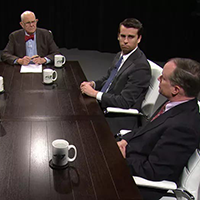Health insurance execs: Costs are going up
Published September 6, 2014
by Owen Covington, Triad Business Journal, August 28, 2014.
Increased patient engagement, more collaboration with providers and the continued move toward paying for quality, not just quantity, are a recipe for helping control health care costs over the long term, the heads of North Carolina's five largest health insurers said during a panel discussion Thursday.
But when given an arrow, and asked to point it in the direction health care costs will go during the next several years, four of the five pointed up, with the fifth being spun around by UnitedHealthcare executiveGarland Scott.
Even with those short-term concerns, each exhibited optimism that changes were already underway that will drastically change the way consumers interact with health insurance and will help provide higher quality health care at a lower price.
"Four years ago, when I was on panels like this, the report would have been that there is little realization or adoption of the idea that change is going to happen," said Brad Wilson, president and CEO of the state's largest insurer, Blue Cross and Blue Shield of North Carolina. "Today, we're not debating whether change or transformation is underway. The conversation is around how we're going to do it together."
Joining Wilson and Scott, who heads UnitedHealthcare in the Carolinas, on the Health Care Stormtracker panel in Durham organized by benefits consulting firm Hill, Chesson & Woodywere: Tracy Baker, president of MidSouth markets for Aetna; Charlie Pitts, the president and CEO of Cigna; and Ken Lewis, president of FirstCarolinaCare.
The insurance companies they represent offer a range of models, including for-profit and nonprofit, as well as the state's only health system-owned insurance company, FirstCarolinaCare, which is based in Pinehurst.
Despite that diversity, the executives frequently echoed each other in talking about changes underway.
Among those changes is a move toward the health insurance business taking on more of a retail mindset, as opposed to most consumers securing coverage by picking from a limited set of options their employers offer.
That's been seen in the launch and use of HealthCare.gov as well as state-based health insurance exchanges brought about by the Affordable Care Act, with eight million people purchasing coverage through the exchanges during the initial enrollment period.
"One of the things we're learning as an industry is that ours is becoming more and more retail every day," said Baker. "We've learned from the exchanges that the consumer is better at buying than we think."
The public perception of health insurance linked to employment is changing. Along with HealthCare.gov and other exchanges, companies are increasingly turning to private exchanges through which employees receive a subsidy from their employers to purchase from a range of plans.
Baker cited studies that forecast that by 2020, close to 75 million people nationally will be buying coverage in some kind of retail environment, whether they be public or private exchanges or other avenues.
"We're seeing more and more employers start to think about defined contribution," Baker said, through which they provide a set amount toward coverage while offering employees more choices.
In response to that change, carriers such as UnitedHealthcare are beefing up the technologies that allow consumers to better interact with information about their coverage and their providers, said Scott, with UnitedHealthcare.
"Consumer engagement is the one thing that will transform health care," Scott said. "We're seeing people make better decisions because they have information on that smartphone we all use."
Those consumers, as they become more involved in selecting and purchasing their health care, must also become more invested in their health, said Pitts, with Cigna.
"The consumer, I believe, shares a lot of the blame for being more passive," Pitts said. "They need to become a more active consumer. They need to demand better tools, and use those tools that are available."
After decades that have seen somewhat of an adversarial relationship between those who deliver health care and those who pay for it, the current trend is one of collaboration and information-sharing between insurers and providers, several executives said.
That's part of providers becoming more invested in improving the quality of the outcome of their care as the payment system shifts away from one that pays doctors based upon how many services or procedures they perform, said Wilson, with Blue Cross Blue and Blue Shield.
"If there is an industry that is ripe for innovation, it's certainly health care because we have been doing the same thing the same old way for a long, long time, and just paying for it and expecting a better outcome," Wilson said.
Increasingly, contracts between physicians and insurance companies have included in them quality metrics, with providers compensated in part on performance.
Scott said in the Carolinas, UnitedHealthcare now has performance-based contracting with at least half of the providers it works with.
Baker echoed that move, noting that Aetna is increasingly moving to a model that has providers sharing some of the risk.
"We're giving them contracts that say, if you hit certain quality and contract measures, you get a check," Baker said. "That's very different from the more you do, the more you make. On the flip side of that, if you don't hit certain measures, you cut us a check that we use to lower premiums."
Those arrangements mean a more collaborative relationship between insurers and doctors. As a health system-owned carrier, that type of collaboration has always been a component of FirstCarolinaCare, said its president, Ken Lewis.
"Everybody would like to point to the other guy as the responsible party for health care costs or health insurance costs," Lewis said. "We all have to participate in how do we get better at what we do."
http://www.bizjournals.com/triad/news/2014/08/28/n-c-insurance-executives-on-the-keys-to-containing.html







